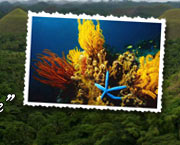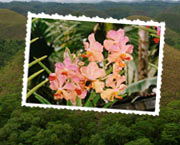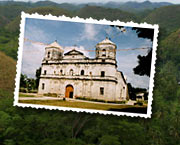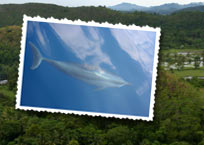A Tour of Churches in Bohol
IJsselstein, Friday, 20 December 2002 (updated: Saturday, 18 March 2006)
Bohol, besides its great natural beauty, also is home to a large number of historical monuments. The most important of these are the numerous stone churches, but also ancient watchtowers, Spanish era convents and municipal halls and houses can be found.
Although I had visited a few of these monuments before, it has long been my desire to make a tour around the island and visit many of these buildings, and during last September, we finally had the opportunity. Since we were to start from Lyn's hometown Cabanugan, a small barangay in the inland of Bohol, we first had to find a mode of transport. We actually only had one choice.... "habal-habal" -- as there are no cars, and the local bus only makes a few trips per day, and doesn't allow you to stop at each place of interest to roam around and explore.
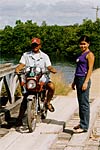
|
|
Lyn with habal- habal driver Warlito. |
"Habal-habal" is the local name for a motorcycle taxi. The driver will sit in front, and the passengers hold on to him on the back seat. Sometimes up to five people can ride, and amazing amounts of luggage can be brought along this way, but we went with just three and only a camera and some snacks to carry along. Habal-habal is actually a great way of exploring Bohol. You can quickly move around, and see much more of the landscape than from a crowded bus or inward looking seat in a jeepney. And better: you can stop at any place that looks interesting and spend some time to explore the place, and then continue your trip whenever you've seen enough. The drawback of course is that you'll be exposed to the elements all day. You'll have the full power of the sun shining on you, and will get wet on an occasional shower of rain, not to mention the incidental insect that will fly in your face. Also, habal-habal is not always for the faint of heart, and you'll have to look for a driver who has a driving style that fits your nerves.
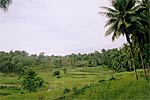
|
|
The rice fields near Tubigon. |
The night before we intended to have our trip, we went out to look for a habal-habal driver who would be willing to ride us around for the whole day, and soon found somebody. At seven o'clock the next morning, he came to pick us up. It is important to go early, as the heat will be less, and the conditions for taking photographs will be better in the morning.
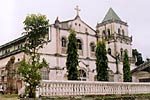
|
| The church of Tubigon. |
Starting from Cabanugan, our first destination is Tubigon, a harbor town on the west coast of Bohol. Although at just a few kilometers distance in a straight line, we have to pass through some quite high hills, with plenty of hairpin bends and great sights over terraced rice fields. We ride about 13 kilometers of rough road through a rough landscape, but arrive in Tubigon in good shape. Here we visit the church of Tubigon. This building, dedicated to San Isidro Labrador (Saint Isodore the Worker) is build of cut coral stone. No exact date for its construction is known, but it was already standing at this location in 1886. The church stands on a hill and looks out over the town across the Bohol straight to the island and city of Cebu. Inside, we admire the ceiling, which is entirely covered with murals on metal sheets, painted by Ray Frances. This artist from Cebu decorated many churches in Bohol in the twenties and thirties of the last century.
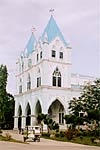
|
|
The church of Calape. |
We continue or trip along the coastal ring road of Bohol towards he South. Our next stop is Calape, a relatively prosperous town, and this prosperity is reflected in its church, which is a new building build from 1933 till 1954 in concrete in a Gothic style, with two towers that can be seen from afar, and offer a great view of the sea and the town. Recently repainted in attractive white and blue, it is, despite its recent construction, still a monument worth a visit. After inspecting the church of Calape and its surrounding areas with the municipal hall, we set out for Loon.
On our way to Loon, we pass through a large area of nipa plantations, and we decide to make a small detour to Pangangan Island. This island, a small distance from the coast is connected with the mainland of Bohol by a small dike and a bridge. Since the dike was constructed, a large mangrove forest was
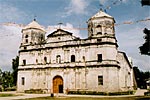
|
| The church of Loon. |
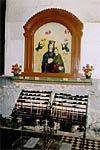
|
|
Inside the church of Loon. |
The town of Loon is divided into a downtown, "Napo," and uptown, "Muto." the church stands near the side of the Napo and a stair of 174 steps near the convento behind the church connects it with the Napo, directly at the seashore. Although a church has been standing on its current location since the 1780s, it has been destroyed by fire no less than three times, and the current stone church was build between 1855 and 1864 by the Augustian Recollects. It is one of the largest churches in Bohol. Inside the church we admire the ceilings, covered with murals by Ray Frances.
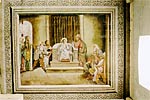
|
| Mural in the church of Loon. |
Our next stop is Maribojoc. Here we first leave the circular road towards the old Spanish watchtower in the barrio of Punta Cruz. This is actually the most famous of a whole series of watch towers build under the Spanish to guard against Moro marauders, who used to make the seas and coastal towns of this part of the Philippines unsafe. Build in 1796 on a triangular plan that is unique in the Philippines. It is called the "Castillo de San Vicente" and inside it still stands a small statue of the saint protector. From the spot of this tower, on the southwestern most point of Bohol, you have an excellent view across the Bohol Sea, and can see the islands of Panglao, Cebu, Negros, and Siquijor.
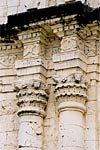
|
|
Detail of the church of Loon. |
From here, we ride to the Maribojoc poblacion or main town of the municipality of Maribojoc. Here we also stop by the church, but since there is a service going on, we cannot enter, and continue our ride to Tagbilaran, the capital city of Bohol. Here we have our lunch, and quickly continue to the town
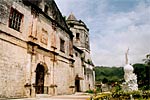
|
| Church of Maribojoc. |
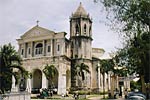
|
| Church of Dauis. |
The island of Panglao has yet another church and interesting watchtower, on the other end of the island, in the town of Panglao, but for now we leave them aside for a later visit, and continue our trip eastwards. Our next destination will be Baclayon. The church of Baclayon, which is one the site of one of the first churches in the Philippines, as a chapel was already present here in 1596, when the Fathers Juan de Torres and Gabriel Sanchez arrived here. However, the current building dates back to 1727. It is a marvelous complex, including the church, an old convento that has been turned into an interesting museum (entrance 10 pesos) of church artifacts, and a school, all facing the Bohol sea, and the pier, on which you can see a large number of colorful bancas of the local fishermen.

|
| Dauis watchtower. |
We again continue our trip towards Loay. We decide not to make a detour to Loboc, although this place houses the oldest church in Bohol (parts of it date back to 1670), as we have visited it before, and have limited time remaining, we wish to use to visit the town of Loay. We pass by the church of
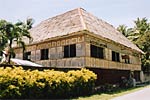
|
|
The Clarin ancestral house in Loay. |
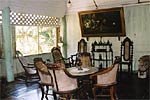
|
|
The sala in the Clarin ancestral house in Loay. |
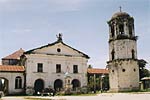
|
| The church in Loay. |
Although it is now a museum, the house still is in urgent need of some repair; some of the ceiling beams are seriously damaged by termites, and need to be replaced. Unfortunately, it will be quite difficult to find wood for such purposes today. When visiting this place, a 20-peso donation towards the maintenance of the house is expected.
Loay is also home to yet another Spanish watchtower, so, to conclude our trip, we decide to look for it. Asking around, few people have ever heard about it, but finally we find somebody who can tell us it is located in the barrio of Villalimpia, and so we head in that direction. We find a small road towards the beach, and ask again. "Not far, just walk that way" is the answer of one of the fishermen, pointing us in the direction of a mangrove forest, so we continue into that forest, only to get lost. After walking around for about half an hour, we come to some houses, and ask again. "Not far, but you have to walk back," and again we search for some time, and without seeing anything reach back to our original point. We ask again, and then the fisherman walks with us, through the thick mangrove, across a patch of nearly submerged land, we finally find it: the Spanish watchtower of Loay: the smallest watchtower on Bohol, and it makes you wonder how useful it was, as it doesn't even rise above the trees.
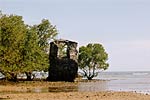
|
| The Loay watchtower. |
Although it is not late, we now start on our long way back home. We ride faster and make less stops, but still enjoy much of the landscape and amazing sights Bohol has to offer. We pass several rivers, on which people transport themselves and their things leisurely on bankas. Along the road near Baclayon, we see a huge balite tree, and in Tagbilaran we stop at some souvenir shops to inspect the wares, and do some shopping in one of the department stores. We then continue back along the coastal road, where we encounter a tricycle loaded with a fat screaming pig, heading for the Loon fiesta the next day. We finally arrive home in Cabanugan just before dusk, enriched with a lot of experiences, a few more filled up rolls of film, and a considerable pain in the bottom from sitting on a motorcycle all day.
How to visit some churches in Bohol
If you desire to visit some churches in Bohol, first go and get the book Visita Iglesia Bohol, by Regalado Trota Jose. This is a very attractive book with loads of details on each church in Bohol, and filled with black and white photographs (also see our review). You probably won't find it in the department stores in Tagbilaran, but copies can be had for 250 pesos at the Bohol Foreign Friendship Foundation (BFFFC), which has its office along CPG East Avenue (near CRBBI and in front of the PCSO lotto station), Tagbilaran City. It's a small walk from the center of Tagbilaran. Their phone number is 501-9390. (Notice: the BFFFC is no longer in operation, please try the National Commission for Culture and the Arts in Manila.)
Unless your starting point is near Tubigon, you probably don't want to follow the route we followed. The book proposes a few tours, and you can choose from them as fits your time schedule. If you can spend a full day, starting from Tagbilaran, you can make your tour from Tagbilaran to Loon, and then back via Punta Cruz, Maribojoc, again Tagbilaran, where you can also visit the Bohol museum, continue to Dauis, Panglao (town), Baclayon, detour to Loboc, then back to the coastal ring road to Alburquerque, and finally Loay, from where you can return to Tagbilaran. If you have limited time, then restrict yourself to Tagbilaran, Dauis, Baclayon, Loboc and Loay, and you can be sure you've seen some of the more important churches.
Jeroen Hellingman
What readers think...
| Maje wrote: |
| Monday, 18 August 2008 03:12:11 PHT |
| I just visited Bohol last July 28 - 30, 2008 and dang!! it was worth to pay a visit again for i did enjoyed so much with a budget tour that gives me almost i wanted to experience/see in Bohol, to mention the dolphins and snorkeling in Bacalisag island and the stop over at the virgin island, every thing is worth a penny in Bohol!! it just cost my companion and i almost 7k for the 3days/2nighy accommodation's with breakfast.. i sure wanted to go back in Bohol, maybe on my honeymoon day... bwuauauhahha!! those who wants to know the tour service agent that i did have on my tour in Bohol, pls pm me.. i will give you all the details.. here is my addy: jed_rajemr_djm@hotmail.com.. - maje! |
| Mark Andre wrote: |
| Wednesday, 23 April 2008 11:15:42 PHT |
| Hi, I've always wanted to take a tour of Bohol's sights. How much do you think a tour would cost? And how would I know if the drivers that approach me are accredited by Bohol's tourism? |
| Jill Alcibar wrote: |
| Sunday, 13 January 2008 11:34:28 PHT |
| As we arrive at the Tagbilaran Port we are met by accredited drivers/tourist guides who offer various themed tours of Bohol. Please include a "Churches of Bohol Tour" for these drivers to offer which mainly focuses on the Colonial Churches....these are wonderful sights to see. And please do invest on literatures of churches to be placed in the Churches themselves to provide tourists with a background of the church, i.e. when built, under whose direction, materials used, etc. Maybe we can have these materials distributed with a Donation Box below it, it would help in maintaining the church and the tourist who has been there would be informed and of course won't forget the sight he saw which he will share with his friends and family. Voila, we have helped Bohol and Philippine Tourism by word of mouth alone. Bohol is gifted with so much history in the Churches alone... Cheers!!!
On the more important churches, you can find plaques with a short history, but yes, why not a booklet in each church with its history... interesting for tourists, and a source of pride for the local population.--Jeroen. |
| Lotlot wrote: |
| Tuesday, 16 October 2007 17:06:36 PHT |
| Tubong-bohol ko bai! keep up the good work mga bol-anon! i really appreciate your site...most of my officemates and friends wanted to visit Bohol and of course hambog ko kaayo nga chada ang Bohol! you'll never regret! pagdala lang daghang kwarta hahahah.... |
| Jonas wrote: |
| Tuesday, 28 March 2006 20:56:29 PHT |
| I am from Bohol and this website never fails to amaze me. Thank you so much. I have long time ago wanted to tour around Bohol to see those churches but I never found time to do it. Each municipality in Bohol has its own church and each church has its own unique features. Even the newly built ones are also very interesting. A complete tour would be a good package. Starting from Tagbilaran Cathedral one can proceed to Cortez, then to Maribojoc and following the coastal road to Calape, Tubigon, Clarin, Inabanga, then to Getape and Talibon. From Talibon the tour can proceed to Ubay via Trinidad, then to the Alicia and then to the coastal towns of Guindulman, Duero, Jagna, Garcia Hernandez, Valencia, Dimiao, Loay. From Loay one can make a side trip to Loboc, Bilar, Carmen and back to Loay then to Baclayon, Alburquerque then Dauis and Panglao. But still this route is not complete because you miss some municipalities like Sagbayan, Anda, Sierra Bullones, San Miguel and Danao. They too have their own churches. A tour like this would probably take more than one day. Hence it should probably include designated places for stopover. |
Read all 18 comments by readers.
Also give your comments on this article
We reserve the right to remove or edit comments posted on this website. Please read our conditions of use for details. You can use <i>italics</i>, <b>bold</b>, <p> new paragraph, <a href="url">link</a>. Other markup will be removed. Use of the forums for advertising is prohibited. Enterprises located in Bohol can request to be added to the business directory.

